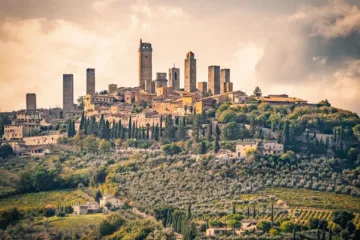
Just one hour from the Mediterranean Sea, under the silent watch of the castle on the hill, lays Jumilla, the epicentre of the appellation of the same name. Winemaking dates back to 3000 BC, and it is the main economic activity in the region.
Geography
Truthfully, the Jumilla region has several peculiarities that make it quite remarkable —located inland, in the southeast of Spain (Murcia), the breezes from the sea and its altitude determine its climate in a very particular way.
Indeed this region enjoys 300 days of sunshine a year. However, the climate is semiarid, with only 300 liters per square meter of annual rainfall, mainly in the autumn and spring. Temperatures can reach 40ºC in summer and drop below zero in winter. It also has a large diurnal range, which allows it to retain the freshness and acidity of the grapes.
The average altitude is 500m above sea level, yet the undulating landscape means the vineyards range from 320m to 900m above sea level, notably affecting temperature and maturation. The soils, mainly limestone, are poor and often covered with white rocks reflecting the sun and heat. However, at the same time, they retain water easily, allowing the vines to keep up in long periods of drought. Under these conditions, the spread of phylloxera is almost impossible. In fact, Jumilla was one of the only Spanish region not affected by the epidemic that devastated Europe from 1869-1880. As a consequence, 80% of the vines are ungrafted.
Due to the combination of climate and soil, it should not be surprising that organic, rain-fed agriculture is particularly prevalent in this region.
Grape Variety
“the Monastrell grape is king”
In these circumstances, the Monastrell grape is king. This varietal is indigenous to the southeast of Spain, although it is probably best known as Mourvèdre in the well-known GSM blends from the southern Rhône region. Regardless, it is the signature grape of the appellation, and its wines are increasing in popularity even outside of Spain.
Monastrell is a late-ripening grape with a compact and tight cluster, thickskinned, medium-sized berries, and is very resistant to drought. Its roots dig deep into the soil in search of water and nutrients, and, given the extreme conditions, the fruit is enriched by concentrating aromas, colour, and flavours.
Main Winery
“Juan Gil is the winery that probably put Jumilla on the map”
“Mainstream” Jumilla’s Monastrell wines are dry, typically single varietal, with a deep layer, ruby colour with violet hues, high alcohol content (reaching 14.5º ABV easily), rough tannins, and medium to low acidity. As a result, the tannins must be tamed by ageing in barrels, typically French oak. Depending on the producer and the desired style, the ageing may be between 6 and 18 months. These wines are fragrant, with aromas of black fruits, pepper, raisins, tobacco, vanilla, and chocolate. These flavours also translate into the palate, complemented with hints of meat and forest floor. They are excellent wines, suitable for cellaring, though some consider them an acquired taste, as they can feel heavy and strong. Juan Gil is the winery that probably put Jumilla on the map. Their collection with the Yellow Label, Silver Label and Blue Label is probably the most famous and the most well-known representation of Jumilla wines abroad, all made in this style.

However, nowadays, there is a new trend consisting in harvesting the grapes before they reach their full maturity. In return, the acidity increases, and the alcohol decreases. The extraction process in the winery focuses on bringing up the fruit rather than colour and tannins, making it unnecessary to engage in barrel ageing. The resulting wines are fresh, with mouthwatering acidity, accentuating the fragrances and flavours of red fruit, local wild aromatic herbs, and even flowers. Ideal for drinking lightly chilled, they are a modern, more approachable alternative for the less trained palates and definitely a must for the summer. The first and foremost winery making wine in this style is Parajes del Valle; its tasting profile and look are very popular among consumers, especially in the Nordics countries and Canada.

Las Rutas del Vino
“Las Rutas del Vino invite the visitor to get to know some of the 40 wineries that are part of the appellation”
The Jumilla region is booming and currently strongly developing its wine tourism related activities. Las Rutas del Vino (“Wine routes”) invite the visitor to get to know some of the 40 wineries that are part of the appellation while participating in events or different activities. A popular event includes live music while enjoying a glass of local wine and some of the region’s delicacies (Jumilla has rich gastronomy – local goat cheese is delicious, but also the cold meats, or the traditional “puchero”). To find more information and the full programme, you can visit rutadelvinojumilla.com.

Also interesting for the visitor are the local festivals, some of them revolving around wine, which are worth enjoying. The most famous is the “Fiesta de la vendimia” (that would translate into something like “Harvest Festivities”), which happens around the 15th of August every year, honouring the wine and the winemakers, where different events and contests take place, both for kids and adults.

Follow me on my Social Media
Wine is a gourmet treasure, do not abuse alcohol!
None of this content has been sponsored
I did not receive any gifts or free samples that could be related to this article


